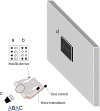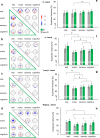Electrophysiological signatures of dedifferentiation differ between fit and less fit older adults
- PMID: 34603546
- PMCID: PMC8448815
- DOI: 10.1007/s11571-020-09656-9
Electrophysiological signatures of dedifferentiation differ between fit and less fit older adults
Abstract
Cardiorespiratory fitness was found to influence age-related changes of resting state brain network organization. However, the influence on dedifferentiated involvement of wider and more unspecialized brain regions during task completion is barely understood. We analyzed EEG data recorded during rest and different tasks (sensory, motor, cognitive) with dynamic mode decomposition, which accounts for topological characteristics as well as temporal dynamics of brain networks. As a main feature the dominant spatio-temporal EEG pattern was extracted in multiple frequency bands per participant. To deduce a pattern's stability, we calculated its proportion of total variance among all activation patterns over time for each task. By comparing fit (N = 15) and less fit older adults (N = 16) characterized by their performance on a 6-min walking test, we found signs of a lower task specificity of the obtained network features for the less fit compared to the fit group. This was indicated by fewer significant differences between tasks in the theta and high beta frequency band in the less fit group. Repeated measures ANOVA revealed that a significantly lower proportion of total variance can be explained by the main pattern in high beta frequency range for the less fit compared to the fit group [F(1,29) = 12.572, p = .001, partial η2 = .300]. Our results indicate that the dedifferentiation in task-related brain activation is lower in fit compared to less fit older adults. Thus, our study supports the idea that cardiorespiratory fitness influences task-related brain network organization in different task domains.
Supplementary information: The online version of this article (10.1007/s11571-020-09656-9) contains supplementary material, which is available to authorized users.
Keywords: Cardiorespiratory fitness; Dynamic mode decomposition; Electroencephalography; Older adults; Spatio-temporal coherent patterns.
© The Author(s) 2021.
Conflict of interest statement
Conflict of interestAuthors declare to have no competing interests.
Figures



Similar articles
-
Classification of visuomotor tasks based on electroencephalographic data depends on age-related differences in brain activity patterns.Neural Netw. 2021 Oct;142:363-374. doi: 10.1016/j.neunet.2021.04.029. Epub 2021 May 13. Neural Netw. 2021. PMID: 34116449
-
Exercise practice associates with different brain rhythmic patterns during vigilance.Physiol Behav. 2020 Oct 1;224:113033. doi: 10.1016/j.physbeh.2020.113033. Epub 2020 Jun 26. Physiol Behav. 2020. PMID: 32598939
-
Aging relates to a disproportionately weaker functional architecture of brain networks during rest and task states.Neuroimage. 2020 Apr 1;209:116521. doi: 10.1016/j.neuroimage.2020.116521. Epub 2020 Jan 8. Neuroimage. 2020. PMID: 31926282
-
Default Mode Network and Neural Phase Synchronization in Healthy Aging: A Resting State EEG Study.Neuroscience. 2022 Mar 1;485:116-128. doi: 10.1016/j.neuroscience.2022.01.008. Epub 2022 Jan 17. Neuroscience. 2022. PMID: 35051530
-
Effects of Cardiorespiratory Fitness on Cerebral Oxygenation in Healthy Adults: A Systematic Review.Front Physiol. 2022 Mar 4;13:838450. doi: 10.3389/fphys.2022.838450. eCollection 2022. Front Physiol. 2022. PMID: 35309063 Free PMC article. Review.
Cited by
-
Exercise-induced central and peripheral sympathetic activity in a community-based group of epilepsy patients differ from healthy controls.Exp Brain Res. 2024 Jun;242(6):1301-1310. doi: 10.1007/s00221-024-06792-0. Epub 2024 Mar 29. Exp Brain Res. 2024. PMID: 38551692 Free PMC article.
-
Source connectivity patterns in the default mode network differ between elderly golf-novices and non-golfers.Sci Rep. 2023 Apr 17;13(1):6215. doi: 10.1038/s41598-023-31893-1. Sci Rep. 2023. PMID: 37069191 Free PMC article.
References
-
- Baringhaus L, Franz C. On a new multivariate two-sample test. J Multivar Anal. 2004;88(1):190–206. doi: 10.1016/S0047-259X(03)00079-4. - DOI
-
- Benjamini Y, Hochberg Y. Controlling the false discovery rate: a practical and powerful approach to multiple testing. J R Stat Soc Series B Stat Methodol. 1995;57:289–300. doi: 10.1111/j.2517-6161.1995.tb02031.x. - DOI
-
- Bohannon RW. Six-minute walk test: a meta-analysis of data from apparently healthy elders. Top Geriatr Rehabil. 2007;23:155–160. doi: 10.1097/01.TGR.0000270184.98402.ef. - DOI
LinkOut - more resources
Full Text Sources
Research Materials

